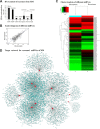Potential role of exosome-associated microRNA panels and in vivo environment to predict drug resistance for patients with multiple myeloma
- PMID: 27129167
- PMCID: PMC5058725
- DOI: 10.18632/oncotarget.9021
Potential role of exosome-associated microRNA panels and in vivo environment to predict drug resistance for patients with multiple myeloma
Abstract
Multiple myeloma (MM) is the second most common hematologic neoplasms and an appropriate in vivo environment for myeloma cells has potential implications for initiation, progression, and metastasis of MM. Exosomes, entities carrying microRNAs (miRNAs) to target locations, participate in the cross-talk between myeloma cells and nonmalignant components of the in vivo environment. This study disclosed the emerging roles of circulating exosome-associated miRNAs in drug resistance (DR) of MM. To this end, the medical records of consecutively hospitalized MM patients, who received novel agents-based therapies, were analyzed. Then, an optimized procedure was established for exosome isolation and exosomal RNA analysis. The exosome-associated miRNA expression patterns for predicting bortezomib (Bz) resistance of MM were further examined using a microarray. In total, 204 patients were enrolled with DR rates of 36.5%, 73.1% and 81.8% in the bortezomib (Bz), thalidomide and lenalidomide containing groups. The serum total light chain ratio ≥ 100, CRP ≥ 20 mg/L, and the second-line usage increased risks of acquired Bz-resistance. Among 68 cases having genetic tests, a high risk factor for predicting de novo DR was 1q21 amplification, which also correlated with lower levels of cholesterol and LDL-C. Moreover, nano-sized exosomes were isolated with significantly increasing internal RNAs and down-regulation of exosomal miR-16-5p, miR-15a-5p and miR-20a-5p, miR-17-5p was revealed in the patients resistant to Bz. The routine workup of MM hardly suggested a value for DR prediction. The circulating exosomes carrying miRNAs provided a window that permits a better understanding of the in vivo intercellular crosstalk in MM patients.
Keywords: exosome; microRNA; microvesicle; myeloma; resistance.
Conflict of interest statement
The authors declare no competing financial interests.
Figures


References
-
- Kyle RA, Durie BG, Rajkumar SV, Landgren O, Blade J, Merlini G, Kröger N, Einsele H, Vesole DH, Dimopoulos M, San Miguel J, Avet-Loiseau H, Hajek R, et al. Monoclonal gammopathy of undetermined significance (MGUS) and smoldering (asymptomatic) multiple myeloma: IMWG consensus perspectives risk factors for progression and guidelines for monitoring and management. Leukemia. 2010;24:1121–1127. - PMC - PubMed
-
- Child JA, Morgan GJ, Davies FE, Owen RG, Bell SE, Hawkins K, Brown J, Drayson MT, Selby PJ. Medical Research Council Adult Leukaemia Working Party. High-dose chemotherapy with hematopoietic stem-cell rescue for multiple myeloma. N Engl J Med. 2003;348:1875–1883. - PubMed
-
- Kristinsson SY, Anderson WF, Landgren O. Improved long-term survival in multiple myeloma up to the age of 80 years. Leukemia. 2014;28:1346–1348. - PubMed
MeSH terms
Substances
LinkOut - more resources
Full Text Sources
Other Literature Sources
Medical
Research Materials
Miscellaneous

